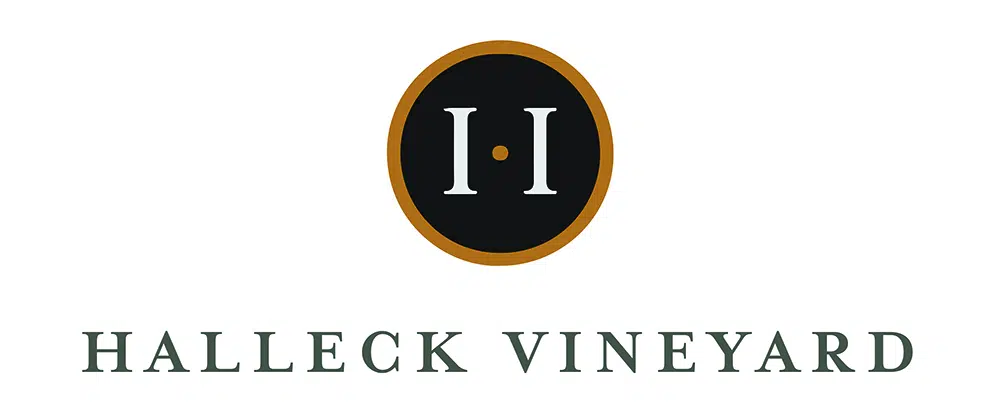
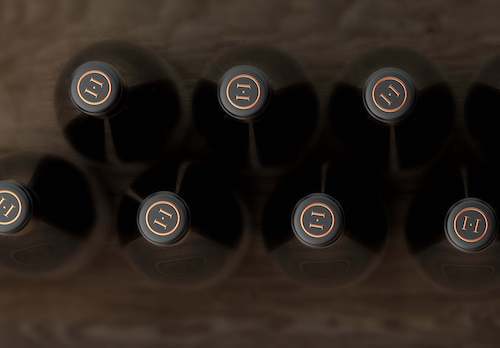
Collection: Pinot Noir | Sommelier's Choice | Buy Direct from Sonoma
18 products
-

Pinot Noir Russian River Three Sons Cuvee, 2019
Halleck Vineyard
- Regular price
- 750ml | $64.00
- Unit price
- / per
Sold out -


Pinot Noir Sonoma Coast Hillside Cuvee, 2019
Halleck Vineyard
- Regular price
- 750ml | $62.00
- Unit price
- / per
Sold out -
Club Only
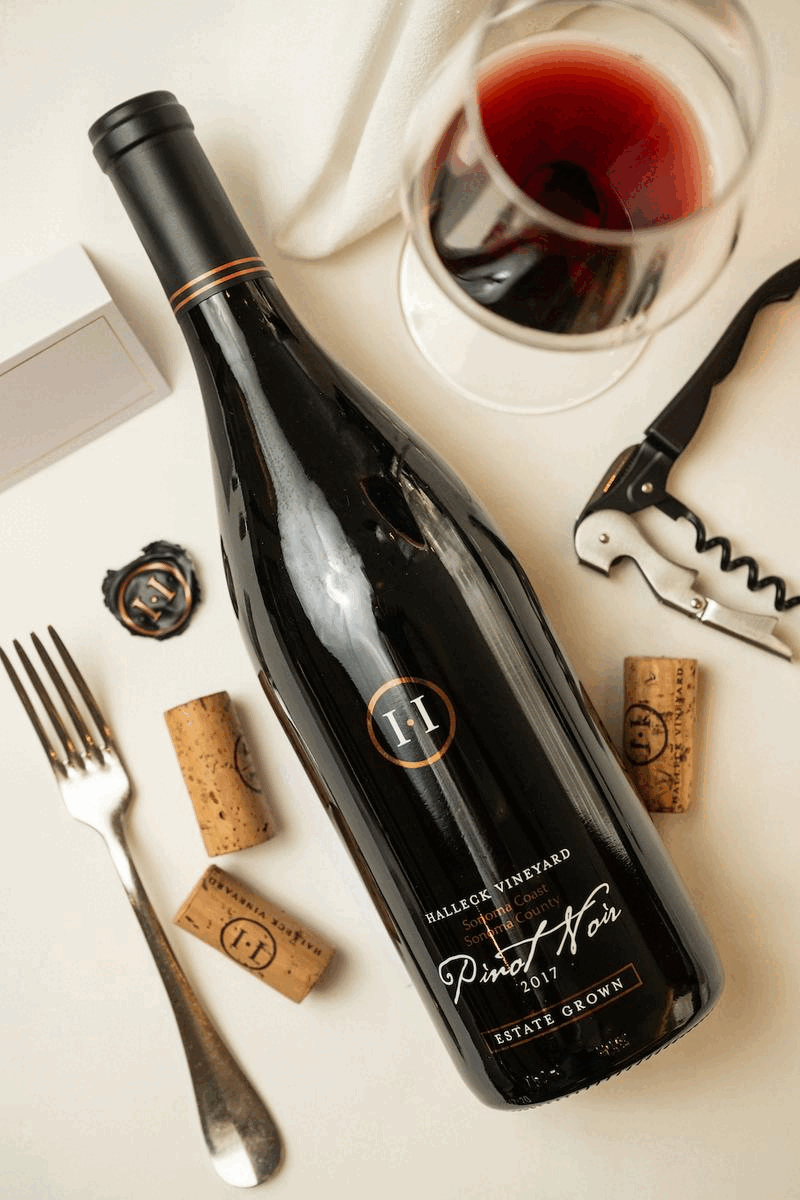
Pinot Noir Sonoma Coast Estate Grown, 2017
Halleck Vineyard
- Regular price
- 750ml | $138.00
- Unit price
- / per
Sold out -
Club Only
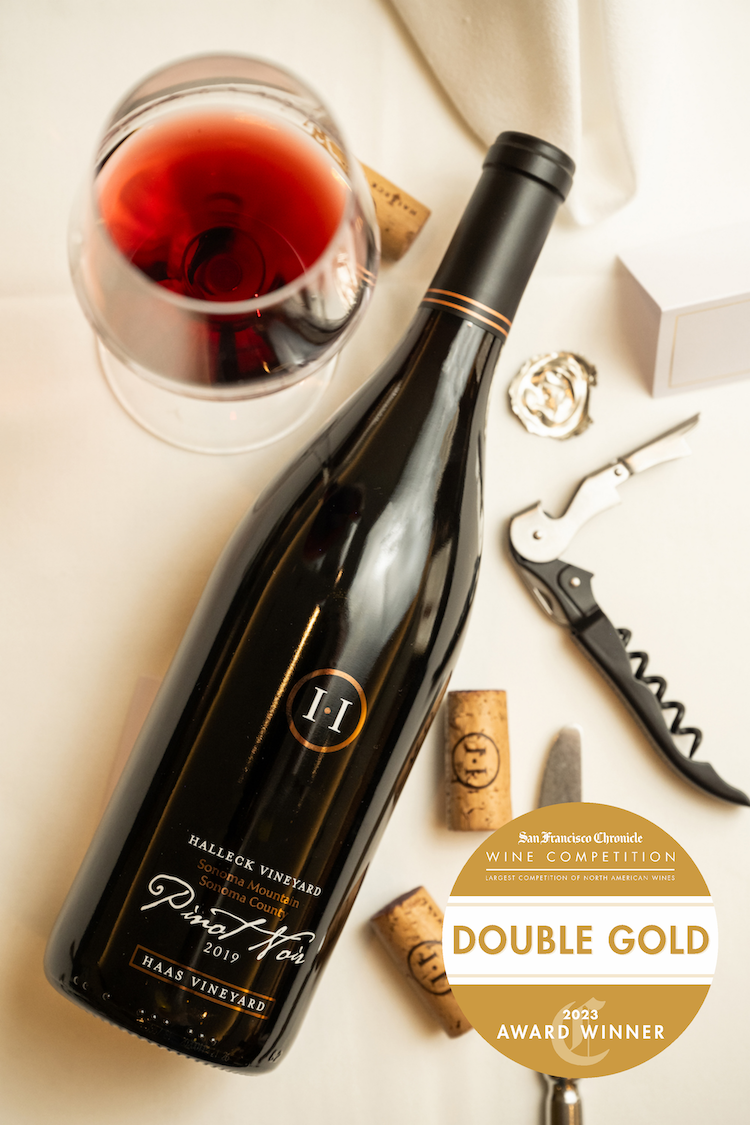
Pinot Noir Sonoma Mountain Haas Vineyard, 2019
Halleck Vineyard
- Regular price
- 750ml | $82.00
- Unit price
- / per
Quick shop for Pinot Noir Sonoma Mountain Haas Vineyard, 2019
-
Sold Out

Pinot Noir Russian River The Farm Vineyard, 2019
Halleck Vineyard
- Regular price
- 750ml | $85.00
- Unit price
- / per
-

Pinot Noir Find Your Light Josh Groban, 2015
Halleck Vineyard
- Regular price
- 750ml | $71.00
- Unit price
- / per
-
Club Only

Pinot Noir Sonoma Coast Clone 828, 2021
Halleck Vineyard
- Regular price
- 750ml | $84.00
- Unit price
- / per
Quick shop for Pinot Noir Sonoma Coast Clone 828, 2021
-

Pinot Noir Find Your Light Josh Groban, 2017
Halleck Vineyard
- Regular price
- 750ml | $65.00
- Unit price
- / per
Sold out -
Club Only
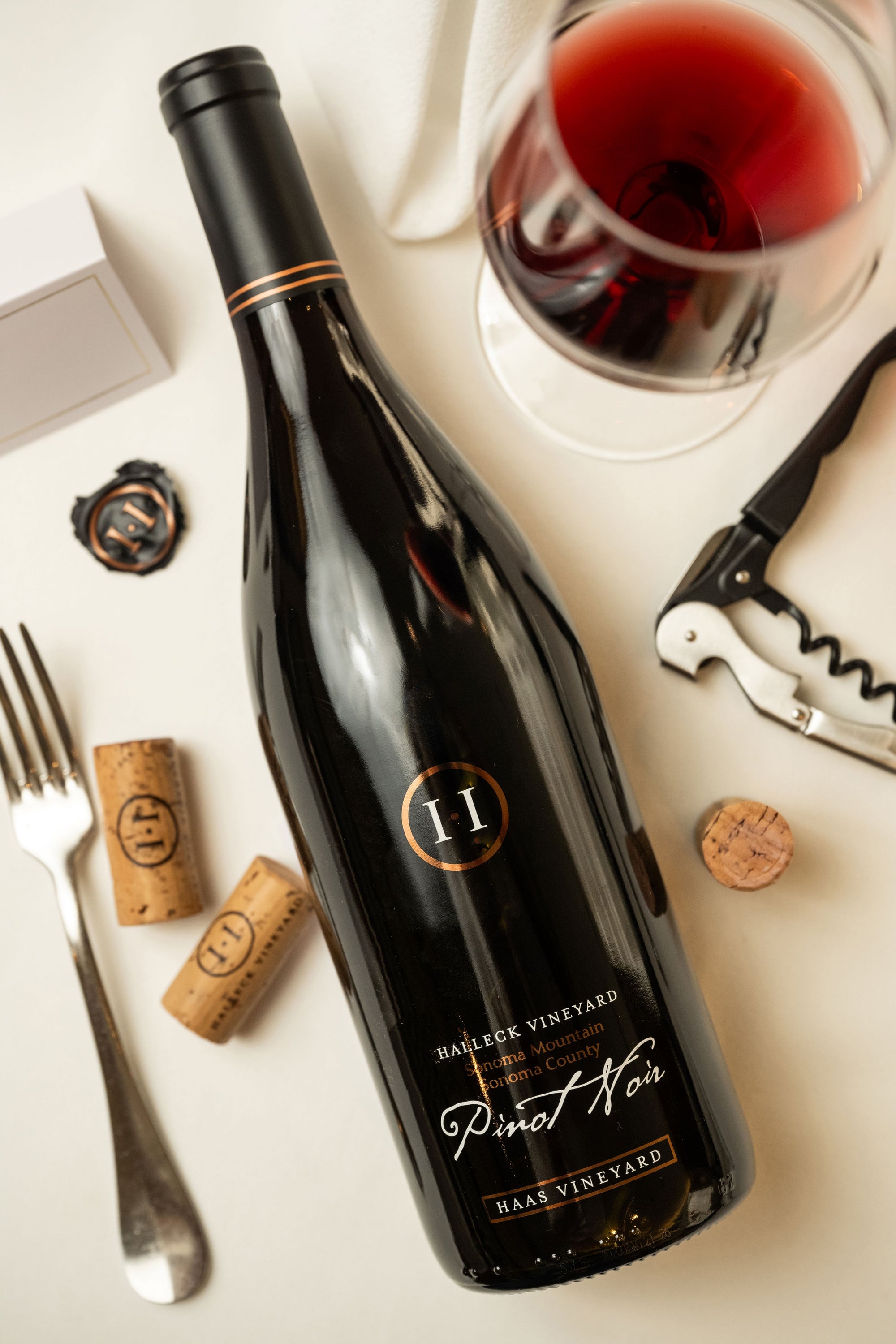
Pinot Noir Sonoma Mountain Haas Vineyard, 2021
Halleck Vineyard
- Regular price
- 750ml | $80.00
- Unit price
- / per
Sold out -
Club Only

Pinot Noir Sonoma Coast Clone 828, 2021
Halleck Vineyard
- Regular price
- 750ml | $84.00
- Unit price
- / per
Sold out -
Sold Out
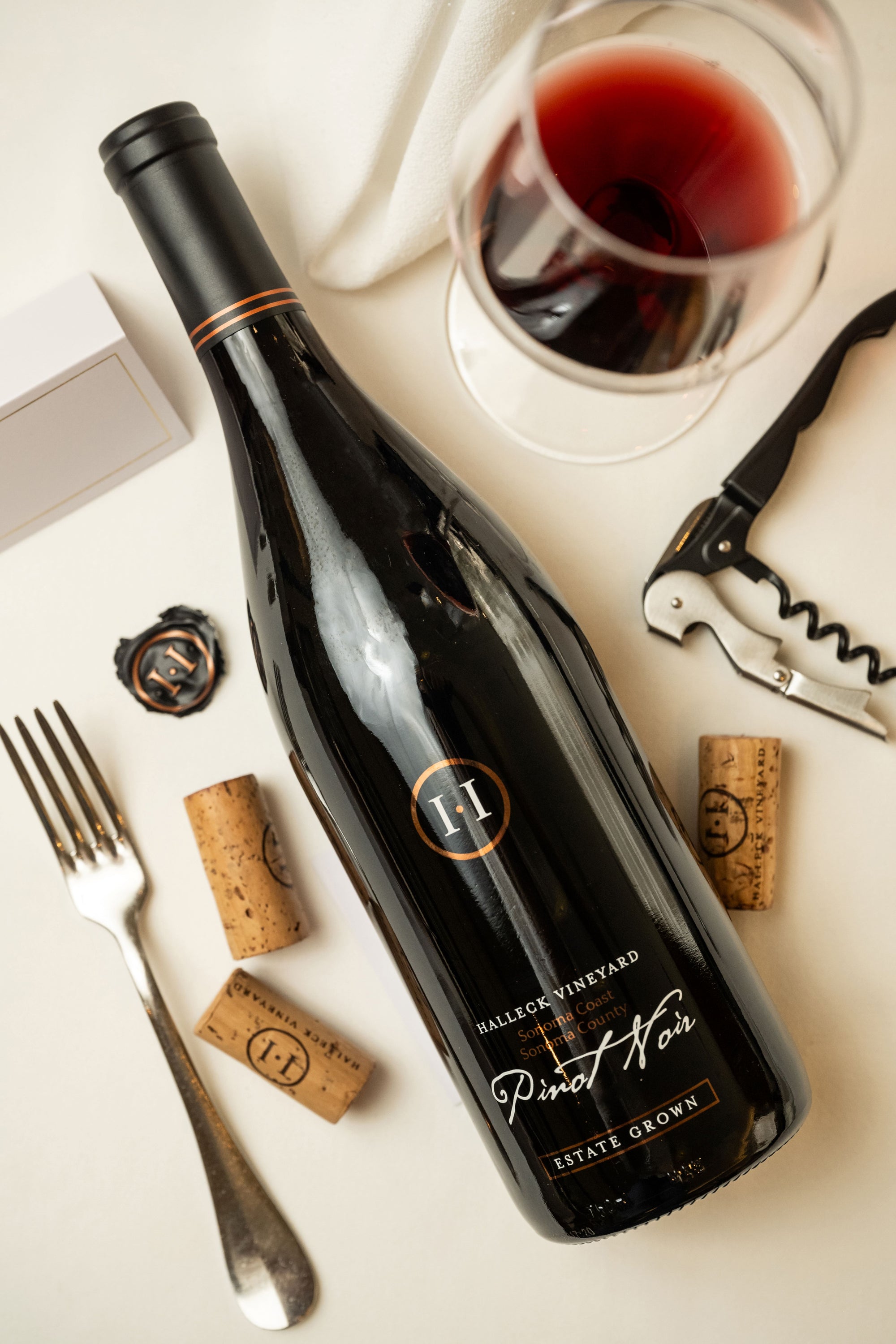
Pinot Noir Sonoma Coast Estate Grown, 2018
Halleck Vineyard
- Regular price
- 750ml | $140.00
- Unit price
- / per
Quick shop for Pinot Noir Sonoma Coast Estate Grown, 2018
-
Club Only

Pinot Noir Sonoma Coast Estate Grown, 2019
Halleck Vineyard
- Regular price
- 750ml | $130.00
- Unit price
- / per
Quick shop for Pinot Noir Sonoma Coast Estate Grown, 2019
Pinot Noirs | Library Wines
-

Library Edition Pinot Noir Russian River The Farm Vineyards, 2010
- Regular price
- 750ml | $115.00
- Unit price
- / per
Quick shop for Library Edition Pinot Noir Russian River The Farm Vineyards, 2010
-
Quick shop for Pinot Noir Russian River The Farm Vineyards, 2008
-

Pinot Noir Russian River Valley Three Sons Cuvee, 2016
- Regular price
- 750ml | $78.00
- Unit price
- / per
Quick shop for Pinot Noir Russian River Valley Three Sons Cuvee, 2016
-
Quick shop for Pinot Noir Russian River Three Sons Cuvee, 2012
-

Pinot Noir Russian River Three Sons Cuvee, 2008
- Regular price
- 750ml | $102.00
- Unit price
- / per
Sold out -
Quick shop for Pinot Noir Sonoma Mountain Haas Vineyard, 2019
-

Dry Gewurztraminer Russian River Calandrelli Vineyard, 2023
- Regular price
- 750ml | $59.00
- Unit price
- / per
Quick shop for Dry Gewurztraminer Russian River Calandrelli Vineyard, 2023
-

Club Offering Pinot Noir Sonoma Mountain Haas Vineyard, 2018
- Regular price
- 750ml | $91.00
- Unit price
- / per
Quick shop for Club Offering Pinot Noir Sonoma Mountain Haas Vineyard, 2018
Pinot Noirs | Russian River Valley
-

Pinot Noir Russian River Three Sons Cuvee, 2019
- Regular price
- 750ml | $64.00
- Unit price
- / per
Sold out -

Library Edition Pinot Noir Russian River The Farm Vineyards, 2010
- Regular price
- 750ml | $115.00
- Unit price
- / per
Quick shop for Library Edition Pinot Noir Russian River The Farm Vineyards, 2010
-

Pinot Noir Russian River Three Sons Cuvee, 2008
- Regular price
- 750ml | $102.00
- Unit price
- / per
Sold out -
Quick shop for Pinot Noir Russian River The Farm Vineyards, 2008
-

Pinot Noir Russian River Valley Three Sons Cuvee, 2016
- Regular price
- 750ml | $78.00
- Unit price
- / per
Quick shop for Pinot Noir Russian River Valley Three Sons Cuvee, 2016
-
Quick shop for Pinot Noir Russian River Three Sons Cuvee, 2012
Pinot Noirs | Sonoma Coast
Pinot Noir | Sonoma Cuvees
-

Pinot Noir Russian River Three Sons Cuvee, 2019
- Regular price
- 750ml | $64.00
- Unit price
- / per
Sold out -

Pinot Noir Russian River Three Sons Cuvee, 2008
- Regular price
- 750ml | $102.00
- Unit price
- / per
Sold out -

Pinot Noir Russian River Valley Three Sons Cuvee, 2016
- Regular price
- 750ml | $78.00
- Unit price
- / per
Quick shop for Pinot Noir Russian River Valley Three Sons Cuvee, 2016
-
Quick shop for Pinot Noir Russian River Three Sons Cuvee, 2012
Pinot Noir: The Basics
Pinot Noir: The Basics
Pinot Noir is a renowned red wine grape that has captured the hearts of wine enthusiasts worldwide. Known for its elegance and versatility, Pinot Noir offers a captivating introduction to the world of wine. With its thin-skinned grapes, it produces light to medium-bodied wines that display a delightful range of red fruit flavors, complemented by earthy and floral undertones. From the prestigious vineyards of Burgundy to the picturesque landscapes of Sonoma and beyond, Pinot Noir's unique characteristics and expression of terroir make it a captivating choice for both new and seasoned wine lovers.
Definition and characteristics of Pinot Noir
Pinot Noir is a red wine grape variety renowned for its distinctive characteristics. With its thin-skinned grapes, it produces light to medium-bodied wines that exhibit an enchanting range of flavors. Pinot Noir often showcases red fruit notes such as cherry, raspberry, and strawberry, accompanied by earthy undertones and delicate floral aromas. Known for its versatility and expression of terroir, Pinot Noir can vary in style and complexity, making each bottle a unique experience. Whether from the historic vineyards of Burgundy or the emerging regions across the globe, Pinot Noir captivates wine enthusiasts with its nuanced profile and elegant charm.
Grape and Vine Characteristics of Pinot Noir
Pinot Noir grapes possess distinct characteristics that contribute to the unique expression of this red wine. Known for their thin skins, Pinot Noir grapes yield light to medium-bodied wines with delicate flavors. The grape variety also exhibits clonal diversity, allowing for variations in taste and aroma profiles. Pinot Noir vines can be susceptible to diseases and are highly sensitive to weather conditions, requiring careful vineyard management. These grape and vine characteristics play a crucial role in shaping the final product, showcasing the beauty and complexity of Pinot Noir wines.
Pinot grapes are thin-skinned
Pinot Noir is known for being a thin-skinned grape, which contributes to its unique characteristics and winemaking qualities. The thin skin of the grape allows for more delicate flavors and lighter color extraction during fermentation. It also means that Pinot Noir wines typically have softer tannins and a lighter body compared to other red wines. The thin skin of the grape requires careful attention during cultivation and winemaking to maintain the grape's delicate nature and capture its full expression in the resulting wine.
Clonal diversity and variations of Pinot Noir
Pinot Noir exhibits a fascinating array of clonal diversity and variations, contributing to the intriguing world of this grape variety. Numerous clones of Pinot Noir exist, each possessing unique characteristics and traits. These clones can influence the flavor profile, color, and structure of the resulting wines. From the well-known Dijon clones to regional variations, the clonal diversity of Pinot Noir allows winemakers to craft wines with distinct expressions, showcasing the range of possibilities this grape offers. This diversity adds to the allure and complexity of Pinot Noir, making it a captivating subject of exploration and experimentation for winemakers and wine enthusiasts alike.
Pinot Noir Clones
Pinot Noir grape clones refer to different genetic variations or selections within the Pinot Noir grape variety. Some notable Pinot Noir grape clones include the Dijon clones (such as 113, 114, 115, 667, and 777), Pommard clone, Martini clone, Wädenswil clone, Swan clone, Calera clone, and Mount Eden clone. Each clone possesses unique characteristics that can influence the flavor profile, vineyard performance, and overall expression of Pinot Noir wines. These clones offer winemakers the opportunity to select and cultivate specific characteristics that suit their desired style and terroir.
Susceptibility to disease and weather conditions
Pinot Noir grapes are known to be susceptible to disease and sensitive to weather conditions, which adds a level of complexity to their cultivation. They are particularly prone to diseases such as mildew and rot, requiring vigilant vineyard management and preventive measures. Additionally, Pinot Noir is sensitive to fluctuations in weather, including temperature, humidity, and rainfall. Adverse weather conditions during the growing season can impact the grape's development and quality. The susceptibility of Pinot Noir to these factors highlights the importance of careful vineyard practices and the influence of climate on the final expression of this grape variety in the resulting wine.
Flavor Profile of Pinot Noir
Pinot Noir is celebrated for its captivating flavor profile, which showcases a delightful range of nuances. Known for its red fruit flavors, such as cherry, raspberry, and strawberry, Pinot Noir offers a spectrum of expressions from fresh and vibrant to ripe and luscious. Beyond the fruit, Pinot Noir often exhibits earthy undertones, including notes of mushroom, forest floor, and subtle floral hints like violet and rose. This combination of fruit and earthy characteristics contributes to the complexity and depth found in Pinot Noir wines, making them a fascinating exploration for wine enthusiasts seeking diverse and engaging flavor experiences.
Red fruit flavors (cherry, raspberry, strawberry)
Pinot Noir is renowned for its enchanting red fruit flavors, which often include the delightful notes of cherry, raspberry, and strawberry. These vibrant and juicy characteristics are hallmarks of many Pinot Noir wines, adding a sense of freshness and liveliness to the palate. The cherry flavors can range from bright red cherries to more luscious and ripe black cherries, while raspberry and strawberry bring their own distinct sweetness and tang. These red fruit flavors contribute to the charm and approachability of Pinot Noir, making it a favorite among wine lovers seeking wines with a fruity and expressive profile.
Earthy and floral undertones (mushroom, forest floor, violet, rose)
Pinot Noir delights with its captivating earthy and floral undertones, adding depth and complexity to its flavor profile. Earthy notes like mushroom and forest floor evoke the aromas of damp soil and the essence of the forest, lending a distinctive and intriguing character to the wine. Alongside these earthy qualities, Pinot Noir often exhibits delicate floral undertones, such as violet and rose. These floral nuances contribute a touch of elegance and aromatic charm to the wine, enhancing its overall sensory experience. The combination of earthy and floral elements adds layers of interest to Pinot Noir, making it a wine that invites exploration and appreciation.
Potential variations in flavor intensity and complexity
Pinot Noir offers the potential for remarkable variations in flavor intensity and complexity, making it a captivating wine to explore. Depending on factors such as vineyard location, climate, soil, and winemaking techniques, Pinot Noir can exhibit a broad range of flavors. Some expressions may showcase vibrant and fruit-forward profiles, bursting with red fruit flavors and youthful freshness. In contrast, other examples may display greater depth and complexity, with layers of nuanced flavors such as spice, earth, and subtle herbal notes. This versatility and potential for diverse flavor profiles contribute to the allure of Pinot Noir, offering wine enthusiasts an exciting journey of discovery with each bottle.
Sugar and Calories in Pinot Noir
The caloric content and sugar level in a typical glass of Pinot Noir can vary depending on the specific wine and its alcohol content. On average, a standard 5-ounce (148 ml) glass of Pinot Noir contains approximately 120-125 calories. As for sugar content, most dry Pinot Noir wines have minimal residual sugar, typically ranging from 0 to 4 grams per liter. However, it's important to note that these values can differ among different brands and styles of Pinot Noir, so it's always a good idea to check the specific wine's label or consult the winemaker's information for precise details.
Like all wines, Pinot Noir is gluten free. And wine does have nutritional value, though it should be consumed in moderation.
Wine is primarily known for its alcohol content, but it also contains various beneficial components. Red wine, in particular, is rich in antioxidants, such as resveratrol, which may have heart-healthy benefits and potentially protect against certain diseases. Additionally, wine contains small amounts of vitamins and minerals, such as potassium and magnesium.
Body and Structure of Pinot Noir
Pinot Noir exhibits a distinct body and structure that sets it apart from other red wines. Generally light to medium-bodied, Pinot Noir wines offer an elegant and delicate mouthfeel. The lower tannin levels in Pinot Noir contribute to its smoothness, making it a wine that can be enjoyed with or without food. The medium to high acidity adds brightness and freshness to the wine, enhancing its overall structure. Pinot Noir's body and structure strike a balance between finesse and flavor, making it a versatile and enjoyable choice for wine lovers seeking a lighter yet satisfying red wine experience.
Light to medium-bodied
Pinot Noir is known for its characteristic light to medium-bodied style. This means that the wine has a lighter weight on the palate compared to full-bodied red wines. The lighter body of Pinot Noir allows for a more delicate and graceful experience, where the flavors and nuances unfold with subtlety. It's this lighter style that contributes to Pinot Noir's versatility, making it a suitable choice for various occasions and food pairings. Whether enjoyed on its own or paired with a range of dishes, the light to medium-bodied nature of Pinot Noir adds to its charm and approachability.
Low to moderate tannins
Pinot Noir is characterized by its low to moderate tannin levels, setting it apart from many other red wines. Tannins are natural compounds found in grape skins and seeds that contribute to the wine's texture and structure. With lower tannins, Pinot Noir wines tend to have a smoother and softer mouthfeel. This attribute enhances the wine's approachability, making it enjoyable even for those who prefer wines with less astringency. The low to moderate tannins of Pinot Noir allow its delicate flavors and aromas to shine through, showcasing the grape's natural elegance and subtlety.
Medium to high acidity
Pinot Noir is known for its medium to high acidity, which adds brightness and liveliness to the wine. Acidity plays a crucial role in balancing the flavors and providing a refreshing sensation on the palate. In Pinot Noir, the acidity brings vibrancy to the red fruit flavors and helps maintain a sense of freshness. This characteristic also contributes to the wine's versatility when it comes to food pairing, as the acidity cuts through rich or fatty dishes, cleansing the palate and enhancing the overall dining experience. The medium to high acidity in Pinot Noir contributes to its lively and engaging nature, making it a favorite choice among wine enthusiasts seeking wines with bright and refreshing characteristics.
Historical background of Pinot Noir
Pinot Noir has a rich historical background that spans centuries. The grape variety has ancient origins, believed to have been cultivated by the Romans. However, it was during the Middle Ages and the influence of monastic orders, particularly the Cistercian monks, that Pinot Noir gained prominence in Burgundy, France. These monks recognized the grape's potential and refined viticultural practices, emphasizing the concept of terroir. Over time, Pinot Noir spread to other regions, both within France and globally, gaining recognition for its unique characteristics and the wines it produces. Today, the historical background of Pinot Noir serves as a testament to its enduring appeal and the dedication of generations of winemakers who have contributed to its legacy.
Ancient Origins of Pinot Noir
Pinot Noir has ancient origins, tracing back to antiquity. Believed to have been cultivated by the Romans, the grape variety has a rich history that spans centuries. Its exact origins are still debated, but its presence in ancient texts and archaeological findings attest to its significance in the wine world. The ancient origins of Pinot Noir highlight its enduring popularity and the long-standing appreciation for its unique qualities. Today, it continues to be cherished as one of the most celebrated and cherished grape varieties in the world of wine.
Monastic Influence on Pinot Noir
Monastic influence played a pivotal role in the cultivation and development of Pinot Noir. During the Middle Ages, monasteries, particularly in Burgundy, France, recognized the potential of this grape variety. Monks in Burgundy, particularly in Côte de Nuits and Côte de Beaune, meticulously tended to vineyards, refining viticultural practices, and preserving winemaking knowledge. Their devotion to quality and terroir expression paved the way for the reputation and prestige of Pinot Noir in the region. The monastic influence on Pinot Noir remains evident in the meticulous vineyard management and winemaking practices employed by modern producers, honoring the legacy of these early pioneers.During the Middle Ages, monasteries played a significant role in preserving and cultivating vineyards, including those of Pinot Noir.
Cistercian Influence on Pinot Noir
The Cistercian influence on Pinot Noir cannot be overstated. These monks, part of the Cistercian order, made significant contributions to the development and refinement of viticulture in Burgundy, France. They recognized the potential of the Pinot Noir grape and emphasized the importance of terroir in winemaking. Through their meticulous observations and vineyard practices, the Cistercian monks furthered the understanding of how different soils and microclimates affected the expression of Pinot Noir. Their dedication to quality and attention to detail set the stage for the exceptional Pinot Noir wines that Burgundy is known for today. The Cistercian influence on Pinot Noir is a testament to their enduring legacy in the world of wine.
Burgundy Grand Cru Wines
In Burgundy, a cru refers to a vineyard of exceptional quality, often divided into parcels owned by different wineries or estates. This classification system originated from observations made by Cistercian and Benedictine monks in the 12th century in the Côte d’Or region. Each vineyard in Burgundy is placed within this hierarchy. At the pinnacle is the Grand Cru, followed by the Premier Cru, then the "village" wines, and finally the generic Bourgogne category at the base.
Burgundy's Cru Hierarchy:
- Grand Cru
- Premier Cru
- "Village" wines
- Bourgogne
Classification and Terroir Recognition of Pinot Noir
Classification and terroir recognition have played vital roles in shaping the reputation and prestige of Pinot Noir. In the mid-19th century, the region of Burgundy implemented a vineyard classification system, recognizing the influence of terroir on wine quality. This system acknowledged the unique characteristics imparted by different soils, slopes, and microclimates within the region. The classification and terroir recognition in Burgundy helped establish a framework for understanding the nuances of Pinot Noir and further emphasized the importance of site selection and vineyard management. Today, the concept of terroir continues to guide winemakers, allowing them to craft distinctive Pinot Noir wines that showcase the expression of their specific vineyard locations.
Global Expansion of Pinot Noir
Pinot Noir has experienced significant global expansion, with the grape being cultivated in various wine regions around the world. The popularity of Pinot Noir wines from Burgundy sparked interest in the grape, leading to its introduction in regions such as California, Oregon, New Zealand, and beyond. These regions recognized the potential of Pinot Noir and its ability to express unique terroir characteristics in their respective climates and soils. The global expansion of Pinot Noir has contributed to its increased availability and allowed wine enthusiasts to explore diverse expressions of this beloved grape, expanding the appreciation for its elegance and complexity on an international scale.
Use of Pinot Noir Grapes in Champagne Sparkling Wine
Pinot Noir holds significant recognition in the world of Champagne. As one of the three primary grape varieties used in Champagne sparkling wine production, alongside Chardonnay and Pinot Meunier, Pinot Noir contributes to the complexity and structure of these renowned sparkling wines. With its pronounced fruitiness and ability to develop rich flavors and aromas during the aging process, Pinot Noir plays a vital role in shaping the character of Champagne. The recognition of Pinot Noir in Champagne highlights its versatility and showcases its ability to excel not only as a still wine but also as a key component in the creation of some of the world's finest sparkling wines.
Modern Pinot Noir Winemaking Techniques
Modern winemaking techniques have greatly influenced the production of Pinot Noir. Winemakers now have access to advanced technologies and practices that allow them to better express the grape's unique characteristics. Techniques such as cold soaking, whole-cluster fermentation, and careful oak aging contribute to the refinement and complexity of Pinot Noir wines. With the use of modern equipment and scientific knowledge, winemakers can ensure optimal extraction of flavors and tannins while preserving the delicate nature of the grape. These modern winemaking techniques have played a significant role in elevating the quality and consistency of Pinot Noir, enhancing its appeal to wine enthusiasts worldwide.
International Accolades and Reputation of Pinot Noir
Pinot Noir has garnered international accolades and built a reputation as one of the most esteemed wine varietals. It has achieved recognition through prestigious wine competitions, ratings, and critical reviews. The reputation of Pinot Noir is built upon the exceptional quality and character of wines produced in renowned regions like Burgundy, Oregon, California, and New Zealand. Its ability to showcase terroir and express a wide range of flavors and complexities has solidified its status as a beloved and sought-after wine. The international accolades and reputation of Pinot Noir continue to reinforce its standing as a captivating and highly regarded varietal among wine enthusiasts and connoisseurs worldwide.
Consumer Appreciation and Market Demand for Pinot Noir
Consumer appreciation and market demand for Pinot Noir have grown significantly over the years. Wine lovers have developed a strong affinity for Pinot Noir due to its approachable nature, versatility, and elegant characteristics. Its lighter body, fruit-forward flavors, and complex profiles have captivated the palates of wine enthusiasts worldwide. As a result, the market demand for Pinot Noir has surged, with consumers actively seeking out bottles from renowned regions and producers. Pinot Noir's ability to pair well with a variety of foods and its reputation for producing high-quality wines has further fueled its popularity. The consumer appreciation and strong market demand for Pinot Noir underscore its enduring appeal and solidify its position as one of the most beloved and sought-after wine varietals in the world.
Continued Exploration and Innovation of Pinot Noir
Continued exploration and innovation are integral to the ongoing evolution of Pinot Noir. Winemakers and viticulturists continuously push boundaries, exploring new regions and experimenting with clones, vineyard practices, and winemaking techniques. They strive to unlock the full potential of Pinot Noir, creating wines that express unique terroir and push the boundaries of flavor and complexity. This relentless pursuit of excellence and innovation ensures that Pinot Noir remains a dynamic and exciting wine category. The exploration and innovation surrounding Pinot Noir contribute to its continued growth and keep wine enthusiasts intrigued by the ever-evolving expressions of this captivating grape variety.
Pinot Noir Vineyards, Grapes and Terroir
Pinot Noir Vineyards, Grapes and Terroir
Pinot Noir grapes and terroir share a profound connection that defines the character of this exceptional wine. The thin-skinned Pinot Noir grapes are highly influenced by the specific terroir where they are grown, including the soil composition, climate, and vineyard location. The Pinot grape's sensitivity to terroir allows it to absorb the unique qualities of the environment, resulting in wines that beautifully reflect their origin.
Why Pinot Noir Grapes are Especially Difficult to Grow
Pinot Noir grapes are renowned for producing some of the most elegant and complex wines, but they are also notoriously difficult to grow. Several factors contribute to the challenges of cultivating Pinot Noir grapes:
- Thin Skin Grapes: Pinot Noir grapes have thin skins compared to other grape varieties. This makes them more susceptible to disease, pests, and damage from weather conditions such as rain, wind, and hail.
- Pinot Noir's Sensitivity to Climate: Pinot Noir is extremely sensitive to its growing environment. It thrives in cool climates with a delicate balance of warmth and sunlight. Too much heat can cause the grapes to ripen too quickly, resulting in a loss of the grape's characteristic flavors and aromas.
- Pinot's Early Budding and Late Ripening: Pinot Noir vines tend to bud early in the spring and ripen late in the growing season. This extended growing period increases the risk of exposure to fires, smoke, frost and cold temperatures during the budding phase and rain and disease pressure closer to harvest.
- Delicate Nature: Pinot Noir is a delicate grape variety that is easily influenced by even minor variations in soil, sunlight, and water availability. This makes site selection crucial, and it often requires careful attention to detail and vineyard management.
- Pinot Noir is a Low Yield Varietal: Pinot Noir vines typically produce fewer grapes per vine compared to other grape varieties. This low yield can make it financially challenging for growers, as it reduces the potential volume of wine produced from a given vineyard.
- Pinot Clonal Variation: There are numerous clonal variations of Pinot Noir, each with slightly different characteristics. This can make it challenging for growers to select the right clones for their specific growing conditions and desired wine style.
- Vineyard Viticulture Management: Successful Pinot Noir cultivation requires meticulous vineyard management. Pruning, canopy management, and disease control are essential to ensure the best grape quality and ripening conditions.
- Winemaking Challenges: Pinot Noir grapes are delicate both in the vineyard and the winery. The winemaking process requires a gentle touch to preserve the delicate flavors and aromas. It's also challenging to strike the right balance between extracting enough color and tannin without overpowering the wine.
Despite these challenges, when cultivated successfully, Pinot Noir grapes can produce wines of extraordinary complexity, elegance, and finesse.
Pinot Noir's Viticulture and Winemaking Techniques
Pinot Noir's Viticulture and Winemaking Techniques
Pinot Noir winemaking techniques are carefully tailored to preserve the delicate nature of this renowned grape variety. Harvesting the grapes at optimal ripeness is crucial, followed by sorting to ensure only the best clusters are selected. Gentle destemming and fermentation methods, such as cold soaking and punch-downs, are employed to extract desired flavors and maintain the grape's inherent elegance. Barrel aging, often in French oak, can contribute to the wine's structure and add subtle nuances. Minimal intervention winemaking, including avoiding excessive extraction or manipulation, allows the unique characteristics of Pinot Noir to shine through. These meticulous techniques harness the grape's potential, resulting in wines that exhibit finesse, complexity, and the true expression of the terroir.
Pinot Noir viticulture, harvesting, vine, and grape selection
Pinot Noir harvesting and grape selection are critical steps in crafting exceptional wines with this revered grape variety. Pinot Noir grapes are carefully handpicked, often in small batches, to ensure gentle handling and preserve their delicate structure. The timing of the harvest is crucial, as it determines the balance of fruit flavors, acidity, and tannin levels. Meticulous grape selection follows, with skilled workers sorting through the grapes to choose only the finest clusters. This careful process eliminates underripe or damaged grapes, ensuring that only the highest quality fruit is used. By prioritizing optimal ripeness and rigorous grape selection, winemakers can harness the full potential of Pinot Noir, creating wines that exhibit elegance, complexity, and the true expression of the varietal.
Pinot Noir red wine vinification process
The vinification process of Pinot Noir is a meticulous and delicate endeavor, aimed at preserving the grape's elegance and capturing its unique characteristics. After the grapes are harvested and sorted, they undergo fermentation, where the natural sugars in the grapes are converted into alcohol. Winemakers often employ gentle maceration techniques, allowing for a controlled extraction of color, flavors, and tannins.
Pinot Noir Fermentation Methods
The use of open-top fermenters or punch-downs enables careful management of the cap (grape skins and solids) during fermentation. Following fermentation, the wine may undergo barrel aging, where it can develop additional complexity and texture. Throughout the vinification process, the focus remains on crafting Pinot Noir wines that reflect the grape's finesse, complexity, and terroir-driven nuances.
Cuviason or maceration
Cuvaison is the French term for the process by which red wine gains color, flavor, and tannins by leaving the juice in contact with the grape skins and pips during fermentation. The English equivalent is “maceration.”
Aging and oak influence
Pinot Noir aging and oak influence are essential aspects of the winemaking process, shaping the character and flavor profile of this esteemed wine. After fermentation, Pinot Noir often undergoes aging, where it matures and develops additional complexity. Oak barrels, particularly those made from French oak, are commonly used during this stage to impart subtle flavors, textures, and aromas. The influence of oak can contribute notes of vanilla, spice, and toasted elements, enhancing the wine's overall structure and depth. However, careful consideration is required to strike the right balance, as excessive oak influence can overpower the delicate nature of Pinot Noir. Skillful winemakers understand the importance of judicious oak aging, allowing the grape's intrinsic qualities to shine while adding a harmonious touch of oak complexity to the final wine.
The role of clones in Pinot Noir production
Clones play a significant role in Pinot Noir production, allowing winemakers to explore and express the diverse characteristics of this grape variety. Pinot Noir clones are genetically distinct variations within the same grape variety. Different clones can exhibit variations in flavor profiles, color, vineyard performance, and disease resistance. By selecting and planting specific clones, winemakers can tailor their vineyards to match desired characteristics and adapt to specific terroirs. Clonal selection also offers the opportunity to create more complex and nuanced wines through blending different clone expressions. The role of clones in Pinot Noir production adds a layer of artistry and customization, contributing to the multitude of styles and expressions found in this captivating wine.
Tasting and Aromas of Pinot Noir
Tasting Pinot Noir is a sensory experience that reveals its captivating aromas and flavors. The wine often exudes delicate and inviting aromas of red fruits like cherry, raspberry, and strawberry, complemented by subtle floral notes. On the palate, Pinot Noir showcases a harmonious balance of fruitiness, acidity, and soft tannins. The flavors range from fresh and vibrant to ripe and complex, with hints of spice, earthiness, and sometimes a touch of smokiness. The elegance and finesse of Pinot Noir make it a wine that captivates the senses and offers a delightful exploration of its nuanced and alluring character.
Primary, secondary, and tertiary aromas
In the world of wine, aromas can be classified into three categories: primary, secondary, and tertiary. Primary aromas are the fruit-driven scents that are characteristic of the grape variety itself, such as the red fruit notes found in Pinot Noir. Secondary aromas develop during fermentation and aging, showcasing characteristics like floral, herbal, or spice notes. Tertiary aromas emerge over time during bottle aging, resulting from complex chemical reactions and aging processes. These aromas include elements such as earthiness, leather, tobacco, and nuances derived from oak aging. The interplay between primary, secondary, and tertiary aromas adds depth and complexity to the sensory experience, making wine tasting a journey of exploration and appreciation.
Flavor profile and tasting notes
The flavor profile of Pinot Noir offers a captivating range of tasting notes that entice the palate. On the forefront, Pinot Noir exhibits delicious red fruit flavors like cherry, raspberry, and strawberry, which provide a vibrant and juicy sensation. Supporting these fruity notes are often earthy undertones, such as mushroom and forest floor, adding depth and complexity to the wine. Delicate floral hints, such as violet and rose, can also be present, enhancing the aromatic experience. As the wine develops, subtle spice nuances may emerge, contributing to its overall complexity. These tasting notes combine harmoniously, creating a wine that is elegant, nuanced, and a pleasure to explore sip by sip.
Describing Pinot Noir's complexity and balance
Pinot Noir is revered for its remarkable complexity and balance, making it a wine of great finesse and sophistication. The complexity of Pinot Noir is evident in its multi-layered flavor profile, which seamlessly combines vibrant red fruit notes with earthy undertones, delicate floral hints, and subtle spice nuances. The interplay of these elements creates a tapestry of flavors that evolve and unfold on the palate, offering a captivating and ever-changing experience. In addition to its complexity, Pinot Noir showcases a beautiful balance between fruitiness, acidity, and tannins. The fruit flavors are well-integrated with the wine's natural acidity, creating a refreshing and lively mouthfeel, while the fine-grained tannins provide a subtle structure that enhances the overall harmony. Pinot Noir's complexity and balance contribute to its status as a wine of exceptional elegance and allure.
Pinot Noirs: Tasting and Aromas
Pinot Noirs: Tasting and Aromas
Tasting Pinot Noir is a sensory experience that reveals its captivating aromas and flavors. The wine often exudes delicate and inviting aromas of red fruits like cherry, raspberry, and strawberry, complemented by subtle floral notes.
On the palate, Pinot Noir showcases a harmonious balance of fruitiness, acidity, and soft tannins. The flavors range from fresh and vibrant to ripe and complex, with hints of spice, earthiness, and sometimes a touch of smoke.
The elegance and finesse of Pinot Noir make it a wine that captivates the senses and offers a delightful exploration of its nuanced and alluring character.
Pinot Noir's primary, secondary, and tertiary aromas
In the world of wine, aromas can be classified into three categories: primary, secondary, and tertiary. Primary aromas are the fruit-driven scents that are characteristic of the grape variety itself, such as the red fruit notes found in Pinot Noir. Secondary aromas develop during fermentation and aging, showcasing characteristics like floral, herbal, or spice notes. Tertiary aromas emerge over time during bottle aging, resulting from complex chemical reactions and aging processes. These aromas include elements such as earthiness, leather, tobacco, and nuances derived from oak aging. The interplay between primary, secondary, and tertiary aromas adds depth and complexity to the sensory experience, making wine tasting a journey of exploration and appreciation.
Pinot Noir flavor profiles and tasting notes
The flavor profile of Pinot Noir offers a captivating range of tasting notes that entice the palate. On the forefront, Pinot Noir exhibits delicious red fruit flavors like cherry, raspberry, and strawberry, which provide a vibrant and juicy sensation. Supporting these fruity notes are often earthy undertones, such as mushroom and forest floor, adding depth and complexity to the wine. Delicate floral hints, such as violet and rose, can also be present, enhancing the aromatic experience. As the wine develops, subtle spice nuances may emerge, contributing to its overall complexity. These tasting notes combine harmoniously, creating a wine that is elegant, nuanced, and a pleasure to explore sip by sip.
Describing the complexity and balance of Pinot Noir vintages
Pinot Noir is revered for its remarkable complexity and balance, making it a wine of great finesse and sophistication. The complexity of Pinot Noir is evident in its multi-layered flavor profile, which seamlessly combines vibrant red fruit notes with earthy undertones, delicate floral hints, and subtle spice nuances. The interplay of these elements creates a tapestry of flavors that evolve and unfold on the palate, offering a captivating and ever-changing experience. In addition to its complexity, Pinot Noir showcases a beautiful balance between fruitiness, acidity, and tannins. The fruit flavors are well-integrated with the wine's natural acidity, creating a refreshing and lively mouthfeel. At the same time, the fine-grained tannins provide a subtle structure that enhances the overall harmony. Pinot Noir's complexity and balance contribute to its status as a wine of exceptional elegance and allure.
Pinot Noir Food Pairing Tips
Pinot Noir Food Pairing Tips
Pinot Noir is highly versatile when it comes to food pairing, making it a beloved choice among wine enthusiasts. Its balanced acidity, moderate tannins, and diverse flavor profile allow it to complement a wide range of dishes. For lighter Pinot Noir styles, consider pairing with grilled salmon, roasted chicken, or mushroom risotto. Medium-bodied Pinot Noir pairs well with roasted duck, seared tuna, or herb-infused pork tenderloin. Fuller-bodied Pinot Noir can stand up to heartier fare like lamb chops, beef bourguignon, or earthy truffle-based dishes. Additionally, the wine's acidity cuts through rich sauces and creamy cheeses, making it an excellent accompaniment to a cheese plate. With its versatility and ability to enhance various culinary experiences, Pinot Noir truly shines as a delightful companion at the dining table.
General Pinot Noir pairing guidelines
When it comes to pairing food with wine, some general guidelines can help create harmonious matches. Consider matching lighter-bodied Pinot Noir with lighter fare such as grilled fish, poultry, or vegetarian dishes. Medium-bodied Pinot Noir pairs well with roasted meats, game, or dishes with earthy flavors. For fuller-bodied Pinot Noir, opt for heartier dishes like stews, braised meats, or aged cheeses. Consider the flavors and intensity of both the food and the wine, aiming for a balance where neither overwhelms the other. Ultimately, personal taste and experimentation play a key role in finding the perfect pairing, so don't be afraid to explore and discover your own preferences.
Specific food pairing recommendations with Pinot Noir
Pinot Noir offers specific food pairing recommendations that can elevate the dining experience. For lighter-bodied Pinot Noir, try pairing it with grilled salmon, roasted chicken, or mushroom risotto for a delightful combination. Medium-bodied Pinot Noir shines alongside roasted duck, seared tuna, or herb-infused pork tenderloin. If you're enjoying a fuller-bodied Pinot Noir, consider pairing it with lamb chops, beef bourguignon, or dishes featuring earthy truffles. Additionally, Pinot Noir's acidity cuts through rich sauces and creamy cheeses, making it a perfect match for a cheese plate. These specific food pairing recommendations capitalize on the wine's characteristics and flavors, creating memorable culinary moments.
Cheese and charcuterie
Cheese and charcuterie boards are fantastic companions to Pinot Noir, offering a delightful culinary experience. Pinot Noir's versatility makes it an ideal match for a variety of cheeses, from soft and creamy Brie or Camembert to semi-hard cheeses like Gruyère or aged Gouda. The wine's acidity cuts through the richness of the cheese, while its fruity and earthy flavors harmonize with the diverse flavors and textures on the board. When it comes to charcuterie, Pinot Noir pairs beautifully with cured meats such as prosciutto, salami, or even duck confit. The wine's elegance and depth complement the savory and umami flavors, creating a balanced and delectable combination. Cheese and charcuterie with Pinot Noir offer an enticing journey of flavors and textures that can be savored and enjoyed.
Seafood and fish
Pinot Noir pairs wonderfully with seafood and fish dishes, creating a delightful harmony of flavors. Lighter-bodied Pinot Noir complements delicate seafood like grilled shrimp, seared scallops, or poached fish, as it enhances the natural flavors without overpowering them. Medium-bodied Pinot Noir beautifully accompanies dishes like roasted salmon, tuna steaks, or fish in a flavorful sauce, providing a balance of fruitiness and acidity. The wine's versatility extends to fuller-bodied Pinot Noir, which can stand up to heartier fish preparations such as grilled swordfish or fish stews. With its ability to accentuate the delicate flavors of seafood and fish while providing a touch of elegance, Pinot Noir is an excellent choice for seafood enthusiasts seeking a captivating wine pairing experience.
Poultry, duck, and game
Pinot Noir is a superb choice when pairing with poultry and game dishes, enhancing their flavors and creating a delightful dining experience. For poultry, Pinot Noir complements roasted chicken, grilled turkey, or duck confit with its balanced acidity and fruity notes. The wine's earthy undertones also complement game dishes such as roasted pheasant, venison, or wild boar. Pinot Noir's medium body and nuanced flavors beautifully interact with the rich flavors and textures of poultry and game, creating a harmonious combination that is sure to please the palate. Whether it's a succulent roast or a gamey delicacy, Pinot Noir adds a touch of elegance and depth to these dishes, making it a winning choice for poultry and game enthusiasts.
Vegetarian dishes
Vegetarian dishes are wonderfully complemented by Pinot Noir, providing a delightful pairing experience. The wine's versatility and vibrant flavors make it a fantastic match for a wide range of vegetarian dishes. For lighter vegetarian fare, Pinot Noir pairs well with grilled vegetables, roasted mushrooms, or vegetable risotto, enhancing their natural flavors. When it comes to heartier dishes like vegetarian lasagna or stuffed bell peppers, Pinot Noir's medium body and earthy undertones complement the savory components. The wine's acidity cuts through rich sauces and cheese, while its fruitiness adds a touch of brightness to the dish. Whether it's a light vegetable medley or a hearty vegetarian creation, Pinot Noir offers a delicious and versatile pairing option for vegetarian enthusiasts.
Pinot Noir: Exploring the Different Regions
Pinot Noir: Exploring the Different Regions
Exploring Pinot Noir from different regions is a captivating journey that unveils the grape's diverse expressions and terroir-driven nuances. Each region, from Burgundy to Oregon, California to New Zealand, offers its own distinct style of Pinot Noir. Burgundy showcases elegance and finesse, Oregon exhibits vibrant fruit and earthiness, California delivers richness and complexity, and New Zealand unveils freshness and purity. By tasting Pinot Noir from various regions, wine enthusiasts can appreciate the influence of climate, soil, and winemaking techniques on the final wine. Exploring Pinot Noir from different regions allows for a deeper understanding of its versatility and the remarkable range of flavors and characteristics it can exhibit.
Burgundy, France
Burgundy, France is the revered birthplace of Pinot Noir, and it continues to hold an esteemed status in the world of wine. The region's unique combination of terroir, climate, and winemaking traditions produces exceptional Pinot Noir wines. Unlike Bourdeaux wine, which has licorice and coffee notes, Burgundy tends to have an earthy bouquet, accompanied by flavors of red cherry, currant, and spice, with gentle tannins and a pleasing minerality.
Burgundy's Pinot Noir is known for its elegance, finesse, and ability to reflect the nuances of its specific vineyard sites. The wines often exhibit delicate red fruit flavors, subtle earthiness, and a beautiful balance of acidity and tannins. With a focus on terroir-driven expressions and a long history of winemaking expertise, Burgundy remains the benchmark for Pinot Noir, captivating wine enthusiasts with its timeless charm and captivating wines.
California, USA
California, USA has emerged as a prominent region for Pinot Noir production, renowned for its bold and expressive wines. The diverse microclimates and varied terroirs across the state provide ideal conditions for cultivating this delicate grape variety. California Pinot Noir often showcases ripe fruit flavors, ranging from luscious black cherries to juicy raspberries, accompanied by hints of baking spices and vanilla.
The wines can exhibit a plush mouthfeel, balanced acidity, and supple tannins. With a blend of innovation and tradition, California winemakers have mastered the art of crafting rich and complex Pinot Noir wines that captivate with their depth and intensity.
California's contribution to the world of Pinot Noir has solidified its place as a prominent and exciting region for wine enthusiasts to explore. All our Pinots are made from grapes grown in vineyards located throughout Sonoma County, California, including:
Russian River Valley Pinot Noirs
Nestled in Sonoma County, California, the Russian River Valley is renowned for its exceptional Pinot Noir wines. The cool-climate terroir, influenced by the nearby Pacific Ocean, allows the grapes to slowly ripen, resulting in wines that boast a delicate balance of red fruit flavors, a captivating earthy undertone, and subtle spiciness. Winemakers in this region embrace sustainable practices, fostering wines that exude elegance and complexity. With aging potential reminiscent of Burgundian style, Russian River Valley Pinot Noirs captivate wine enthusiasts with their vibrant aromas, rich flavors, and remarkable burstiness, showcasing the true essence of this celebrated grape variety.
Sonoma Coast Pinot Noirs
Nestled along the scenic California coastline, Sonoma Coast is renowned for producing exceptional Pinot Noir wines. The coastal terroir, influenced by the nearby Pacific Ocean and its cooling fog, creates a unique microclimate perfect for this delicate grape variety.
In fact, the Court of Master Sommeliers includes Sonoma Coast Pinot Noir on their list of examinable red wine varieties and regions. The vineyards of Sonoma Coast yield wines with a captivating burstiness, ranging from vibrant red fruit flavors to subtle forest floor and mineral notes. Winemakers embrace sustainable practices, crafting Pinot Noirs that showcase both elegance and complexity. With their intriguing aromatics and aging potential, Sonoma Coast Pinot Noirs entice wine enthusiasts with an immersive experience, celebrating the beauty of the coastal terroir in every sip.
Sonoma Mountain Pinot Noirs
Perched on the slopes of Sonoma Mountain, the Pinot Noir wines from this region offer a captivating expression of the mountain terroir. The elevated vineyards benefit from a unique microclimate, with cool evenings and ample sun exposure, imparting vibrant red fruit flavors to the grapes. Volcanic soils further enhance the wine's complexity, contributing to its age-worthiness and Burgundian-style finesse. Winemakers embrace sustainable practices, showcasing the terroir-driven character of Sonoma Mountain Pinot Noir. With its rich aromatics and refined structure, this wine entices wine enthusiasts and pairs seamlessly with a variety of cuisines, making it a true gem from the Sonoma wine country.
Oregon, USA
Oregon, USA has established itself as a leading region for producing exceptional Pinot Noir wines. The cool climate and diverse terroirs, particularly in the Willamette Valley, provide ideal conditions for growing this delicate grape variety. Oregon Pinot Noir is known for its elegance, finesse, and purity of fruit expression. The wines often display vibrant red fruit flavors, such as cherry and raspberry, along with earthy undertones and floral nuances. With a focus on sustainable and organic practices, Oregon winemakers craft Pinot Noir wines that showcase the unique characteristics of their vineyards. Oregon's commitment to quality and its ability to produce captivating, terroir-driven Pinot Noir have firmly established it as a region of great significance in the world of wine.
New Zealand
New Zealand has emerged as an exciting and vibrant region for Pinot Noir production, offering a distinct expression of this beloved grape variety. With its cool maritime climate and diverse terroirs, particularly in regions like Marlborough and Central Otago, New Zealand has captured attention with its fresh and vibrant Pinot Noir wines. These wines often showcase bright red fruit flavors, such as cherry and raspberry, accompanied by floral notes and subtle spice. The cool climate contributes to the wine's refreshing acidity and elegant structure, resulting in well-balanced and food-friendly Pinot Noir. New Zealand's dedication to sustainable viticulture and meticulous winemaking practices have positioned it as a noteworthy player in the global Pinot Noir landscape, captivating wine enthusiasts with its unique and terroir-driven expressions.
Other notable Pinot Noir winegrowing regions
In addition to Burgundy, California, Oregon, and New Zealand, there are several other notable regions that produce exceptional Pinot Noir wines. These regions include Alsace in France, known for its aromatic and textured Pinot Noir; Germany's Baden region, producing elegant and mineral-driven examples; Italy's Alto Adige, offering vibrant and nuanced expressions; Australia's Yarra Valley, delivering complex and fruit-forward Pinot Noir wines; and South Africa's Hemel-en-Aarde Valley where the cool-climate conditions and diverse terroirs yield exceptional wines. Each of these regions brings its own unique terroir, winemaking techniques, and flavor profiles to the world of Pinot Noir, contributing to the global diversity and appreciation of this captivating grape variety. Exploring Pinot Noir from these other notable regions provides a thrilling opportunity to discover the diverse expressions and interpretations of this beloved wine.
Pinot Noir Appreciation and Cellar Management
Pinot Noir Appreciation and Cellar Management
Pinot Noir wine appreciation and cellar management are essential for fully experiencing and preserving the qualities of this esteemed grape variety. Wine enthusiasts appreciate the nuanced flavors, delicate aromas, and complex character of Pinot Noir through thoughtful tasting and exploration.
Proper cellar management ensures that Pinot Noir wines are stored optimally, including consistent temperature, humidity, and minimal exposure to light and vibrations. By carefully curating a collection of Pinot Noir, understanding its aging potential, and organizing the cellar, enthusiasts can create a haven for these wines to evolve and reach their full potential. Pinot Noir wine appreciation and cellar management contribute to the ongoing enjoyment and preservation of this captivating and age-worthy wine.
Pinot Noir glassware and serving temperature
Glassware and serving temperature play a crucial role in thoroughly enjoying the nuances of Pinot Noir. Selecting the appropriate glass, such as a Burgundy or Pinot Noir-specific glass, enhances the wine's aromas and allows for proper aeration.
The tulip-shaped bowl of these glasses enhances a wine's flavor by exposing it to fresh air, and allowing it to breathe. Much like a decanter, this wine glass style captures and concentrates the delicate aromatics, while the wider opening allows for the appreciation of the wine's bouquet.
Best Temperature for Serving Pinot Noir
Serving Pinot Noir at the correct temperature, typically between 55°F and 60°F (12°C and 15°C), ensures optimal enjoyment. Cooler temperatures preserve the wine's freshness and acidity, while warmer temperatures can enhance its aromatics and smooth out its structure. By paying attention to glassware and serving temperature, wine enthusiasts can fully appreciate the complexities and nuances of Pinot Noir.
Proper Pinot Noir cellar bottle storage and aging
Proper storage and aging are crucial for preserving and enhancing the qualities of Pinot Noir wines. It is essential to store Pinot Noir bottles in a cool, dark, and humidity-controlled environment to protect them from heat, light, and temperature fluctuations. Horizontal bottle placement helps keep the cork moist, preventing premature oxidation. Pinot Noir wines can benefit from aging, as they develop greater complexity and elegance over time. Understanding the ideal aging potential for each bottle allows wine enthusiasts to determine the optimal time to enjoy it. Patience is key, as aging Pinot Noir allows its flavors and aromas to evolve, resulting in a more harmonious and refined wine. Proper storage and aging practices ensure that each bottle of Pinot Noir is enjoyed at its peak, rewarding wine lovers with a truly remarkable experience.
Collecting and investing in Pinot Noir
Collecting and investing in Pinot Noir wines can be a rewarding endeavor for wine enthusiasts and investors alike. As a highly regarded and sought-after grape variety, Pinot Noir has the potential to increase in value over time. Building a collection of notable vintages, limited editions, or wines from esteemed vineyards allows collectors to appreciate the wine's evolving beauty and potentially benefit from its appreciation in market value. To make informed investments, knowledge of the producer's reputation, vineyard quality, and the wine's aging potential is essential. Proper storage conditions and provenance documentation are crucial for maintaining the wine's integrity and investment value. Collecting and investing in Pinot Noir not only provides the pleasure of enjoying exceptional wines but also the opportunity to build a valuable collection over time.
Pinot Noir Culture and Tourism
Pinot Noir Culture and Tourism
Pinot Noir wine culture and tourism have flourished, drawing enthusiasts to explore the regions and vineyards where this esteemed grape variety thrives. Wine lovers flock to iconic destinations like Burgundy, Oregon's Willamette Valley, California's Sonoma Coast, and New Zealand's Marlborough, immersing themselves in the rich heritage and unique terroirs that shape Pinot Noir wines. Winery tours, vineyard visits, and wine festivals provide opportunities to taste and learn about the diverse expressions of Pinot Noir, while also experiencing the local culture and hospitality. Pinot Noir wine tourism allows enthusiasts to deepen their appreciation for this captivating wine, forging connections with winemakers, fellow enthusiasts, and the regions themselves. It is a delightful journey of exploration, education, and enjoyment that celebrates the cultural and sensory allure of Pinot Noir.
Pinot Noir festivals and events
Wine festivals and events are vibrant celebrations that bring together wine enthusiasts and industry professionals to revel in the world of wine. These gatherings offer a unique opportunity to explore and experience a wide array of wines, including Pinot Noir. Wine festivals showcase the craftsmanship of winemakers, allowing attendees to taste different vintages, discover new producers, and learn about various wine regions. From interactive tastings to educational seminars, these events provide a platform for sharing knowledge, fostering connections, and celebrating the art of winemaking. Whether it's a local wine festival or a grand international event, wine festivals are cherished occasions that unite wine lovers in their passion for the captivating world of wine.
- International Pinot Noir Celebration (IPNC) - Held in Oregon, USA, this renowned event brings together Pinot Noir producers and enthusiasts from around the world for tastings, seminars, and vineyard tours.
- World of Pinot Noir (WOPN) - Taking place in California, USA, this event showcases Pinot Noir from both domestic and international producers. Attendees can enjoy tastings, educational sessions, and gourmet food pairings.
- Pinot Days - Held in multiple cities across the United States, Pinot Days is a series of events where wine lovers can taste an extensive selection of Pinot Noir wines from various regions.
- Burgundy Wine Festival - Taking place in Burgundy, France, this festival celebrates the region's iconic Pinot Noir wines. It features tastings, cellar visits, and special events dedicated to Burgundy's rich viticultural heritage.
- Mornington Peninsula Pinot Noir Celebration - Held in Victoria, Australia, this event focuses on showcasing the cool-climate Pinot Noir wines produced in the Mornington Peninsula region. Attendees can participate in tastings, winery tours, and educational sessions.
- Central Otago Pinot Noir Celebration - Based in New Zealand's Central Otago region, this celebration highlights the world-class Pinot Noir wines produced in the area. It includes tastings, vineyard visits, and panel discussions on Pinot Noir production.
- Hemel-en-Aarde Pinot Noir Celebration - Taking place in South Africa's Hemel-en-Aarde Valley, this event focuses on the exceptional Pinot Noir wines produced in the region. Attendees can enjoy tastings, winery tours, and food pairings.
Wine tours and tasting experiences
Wine tours and tasting experiences offer immersive journeys into the world of wine, allowing enthusiasts to discover and appreciate the nuances of different varietals, including Pinot Noir. Guided tours of vineyards and wineries provide insights into the winemaking process, from grape to bottle. Tasting experiences allow visitors to sample a range of wines, exploring the flavors, aromas, and textures that each offers. Engaging with knowledgeable guides and winemakers enhances the experience, as they share stories and expertise about the wines and the region. Wine tours and tasting experiences create memorable moments of sensory delight, deepening the understanding and enjoyment of wines such as Pinot Noir, while also fostering a deeper connection to the rich world of winemaking.
Pinot Noir-related tourism destinations
Pinot Noir-related tourism destinations have emerged as must-visit locations for wine enthusiasts seeking to delve into the world of this captivating grape variety. Regions like Burgundy in France, the Willamette Valley in Oregon, the Russian River Valley in California, and Central Otago in New Zealand have become renowned for their exceptional Pinot Noir wines. These destinations offer picturesque vineyards, charming wineries, and cellar door experiences that allow visitors to immerse themselves in the beauty of the vineyards and taste the distinctive expressions of Pinot Noir. From vineyard tours to wine tastings, these destinations provide an opportunity to explore the terroir, learn about winemaking techniques, and indulge in the pleasures of Pinot Noir. Pinot Noir-related tourism destinations are truly a haven for wine lovers, offering an enriching and unforgettable experience.
Pinot Noir: Finding the Perfect Pinot
Pinot Noir: Finding the Perfect Pinot
The world of Pinot Noir offers a fascinating journey into the realm of wine. From its distinct characteristics and historical background to the influence of terroir and winemaking techniques, Pinot Noir embodies complexity and balance.
Pinot Noir's Aromas
Pinot Noir's aromas, flavor profile, and versatility in food pairing make it a sought-after wine choice. Whether you savor a Burgundy from France, a California Pinot Noir, or a New Zealand delight, each region adds its unique touch. Wine appreciation, cellar management, and wine-related tourism further enrich the experience. Pinot Noir's allure continues to captivate wine enthusiasts, making it a compelling choice for those seeking a remarkable and nuanced wine-drinking adventure.
Principles of Pinot Noir
We delved into Pinot Noir wine’s definition, characteristics, and historical background. We explored the influence of grape variety and terroir and identified notable wine regions for Pinot Noir production.
We uncovered the winemaking techniques, including harvesting, vinification, aging, and the role of clones. We discussed the tasting experience, aromas, and flavor profile of Pinot Noir, as well as its versatility in food pairing. We traveled through various regions, such as Burgundy, California, Oregon, and New Zealand. We discovered the significance of wine appreciation, cellar management, and wine culture in relation to Pinot Noir. Lastly, we recapped the key points, emphasizing its complexity, balance, and overall appeal.
And now, it's your turn to try this enchanting, lovely red wine varietal.
Pinot Noir Glossary
Pinot Noir Glossary
- Pinot Noir
- Wine
- Grape
- Vineyard
- Winery
- Terroir
- Climate
- Soil
- Appellation
- Region
- Vintage
- Harvest
- Tasting
- Aromas
- Flavors
- Red wine
- Fruit-forward
- Balance
- Complexity
- Elegant
- Smooth
- Tannins
- Oak
- Aging
- Cellar
- Bottle
- Winemaker
- Estate
- Viticulture
- Enology
- Barrel
- Cork
- Glass
- Pairing
- Food
- Culinary
- Cheese
- Mushroom
- Duck
- Lamb
- Salmon
- Roast
- Earthy
- Spicy
- Berry
- Cherry
- Raspberry
- Strawberry
- Plum
- Blackcurrant
- Herb
- Floral
- Vanilla
Pinot Noir: Related Terms
Pinot Noir: Related Terms
- Pinot Noir
- Red wine
- Grape variety
- Terroir
- Wine regions
- Burgundy
- California
- Oregon
- New Zealand
- Clones
- Vinification
- Aging
- Oak influence
- Tasting notes
- Aromas
- Flavor profile
- Complexity
- Balance
- Food pairing
- Cheese
- Seafood
- Poultry
- Game
- Vegetarian dishes
- Glassware
- Serving temperature
- Wine storage
- Wine appreciation
- Cellar management
- Wine festivals
- Wine tours
- Tasting experiences
- Wine culture
- Wine tourism
- Pinot Noir grapes
- Wine production
- Vineyards
- Climate
- Soil
- Harvesting
- Grape selection
- Winemaking techniques
- Wine regions of France
- Wine regions of the USA
- Wine regions of New Zealand
- Old World wines
- New World wines
- Wine appellations
- Wine classification
- Pinot Noir clones
- Pinot Noir styles
- Pinot Noir blends
- Pinot Noir characteristics
- Pinot Noir aging potential
- Pinot Noir terroir influence
- Pinot Noir history
- Pinot Noir evolution
- Pinot Noir growth
- Pinot Noir flavors
- Pinot Noir wineries
- Pinot Noir producers
- Pinot Noir vintages
- Pinot Noir tasting
- Pinot Noir glassware
- Pinot Noir temperature
- Pinot Noir food pairing
- Pinot Noir aging
- Pinot Noir oak barrels
- Pinot Noir aroma wheel
- Pinot Noir descriptors
- Pinot Noir winemakers
- Pinot Noir sommeliers
- Pinot Noir regions comparison
- Pinot Noir soil types
- Pinot Noir grape clusters
- Pinot Noir harvest season
- Pinot Noir wine barrels
- Pinot Noir vineyard management
- Pinot Noir fermentation process
- Pinot Noir color intensity
- Pinot Noir aging process
- Pinot Noir wine classification
- Pinot Noir appellations and terroir
- Pinot Noir wine and food pairing
- Pinot Noir tasting techniques
- Pinot Noir regional characteristics
- Pinot Noir aging and cellaring
- Pinot Noir and food culture
- Pinot Noir and wine history
- Pinot Noir and winemaking trends
- Pinot Noir winery visits
- Pinot Noir wine festivals
- Pinot Noir vineyard tours
- Pinot Noir wine appreciation courses
- Pinot Noir wine tastings
- Pinot Noir food and wine pairing events
- Pinot Noir wine tourism destinations
- Pinot Noir winemaking traditions
- Pinot Noir wine regions and climates
